Description
As built, LV-83 was one of the nation's new third-generation lightships, with an all-steel hull, wooden decks, and a powerful double-expansion steam engine. It measured 112 feet (34 m) on the keel, 133 feet overall, with a beam of 28 feet 6 inches (8.69 m) and a draft of 12 feet 6 inches (3.81 m), and was rated at 668 tons. The beakhead roller on the bow was later removed, reducing length overall to 129 feet 6 inches.
The ship's aids to navigation currently include a 1,000-watt beacon light, a 140-decibel Diaphone horn, and a 1,000-pound (450 kg) foredeck fog bell. At the time of launching, however, the beacon consisted of a chandelier of three oil lamps that could be hoisted up the masts from the deck. These were originally powered by whale oil, then first converted to kerosene, and finally electrified in 1930. [4] A 12-inch diameter steam whistle was the primary sound signaling device on board with the 1,000-lb bell standing by as the auxiliary. For a time, LV-83 was also fitted with an underwater bell with a mechanical striker that would strike out the ship's identity as a submarine signal. Sound carries much farther in water, extending the range of the ship's signals. The underwater bell was removed when a radio beacon was fitted on the ship for long-range signaling. [4] [5] [6]
For propulsion, LV-83 was driven by a single 8-foot diameter screw powered by a 375-horsepower marine steam engine, originally fed by a pair of coal-fired fire-tube Scotch boilers. The ship had two coal bunkers, each with a capacity of 75 tons, and freshwater tankage for more than 11,000 gallons. In 1934, the Scotch boilers were replaced with modern oil-fired watertube boilers, improving endurance, speed of bunkering, and speed in raising steam while simultaneously reducing the size of the boiler room crew. [4]
During active service, LV-83's normal crew complement was 15, with 10 on duty at any given time. The others were on shore leave rotation. Crew size did fluctuate slightly with technological modifications such as the labor saving oil-fired boilers or the successive waves of new electronic devices like radio and radar. During World War II, the ship's complement increased to more than 30 to man the guns fitted aboard for war duty. [5]
History
LV-83 was launched in Camden, New Jersey in 1904, and was deployed to the West Coast to serve on the Blunt's Reef lightship station. Since the Panama Canal would not be completed for another decade, LV-83 (accompanied by LV-76) had to steam around the tip of South America and north to San Francisco to reach its first station assignment at Blunts Reef off Crescent City, California. While there, the ship rescued 150 people from the steamer Bear after that ship ran aground on the reef in dense fog. [5]
Formerly known as Relief, LV-83 had numerous names on its sides, all of which indicated the location of its station. Swiftsure refers to the Swiftsure Bank near the entrance to the Strait of Juan de Fuca, which separates Washington from Vancouver Island. She also guided ships near Umatilla Reef and the Columbia River Bar.
The ship was decommissioned in 1960, and purchased by Northwest Seaport in 1966. It is listed on the National Register of Historic Places, was declared a National Historic Landmark in 1989, and is on the Washington State Heritage Register. LV-83 is docked on Lake Union, in Seattle, Washington, where a long-running restoration was begun in 2008. LV-83 is open to visitors on most summer weekends, or by appointment.

A lightvessel, or lightship, is a ship that acts as a lighthouse. They are used in waters that are too deep or otherwise unsuitable for lighthouse construction. Although some records exist of fire beacons being placed on ships in Roman times, the first modern lightvessel was off the Nore sandbank at the mouth of the River Thames in England, placed there by its inventor Robert Hamblin in 1734. The type has become largely obsolete; lighthouses replaced some stations as the construction techniques for lighthouses advanced, while large, automated buoys replaced others.
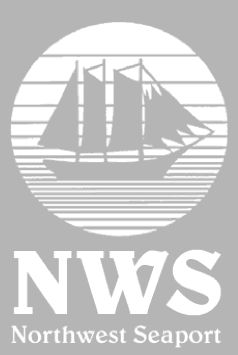
Northwest Seaport Maritime Heritage Center is a nonprofit organization in Seattle, Washington dedicated to the preservation and interpretation of Puget Sound and Northwest Coast maritime heritage, expressed through educational programs and experiences available to the public aboard its ships. The organization owns three large historic vessels docked at the Historic Ships' Wharf in Seattle's Lake Union Park; the tugboat Arthur Foss (1889), Lightship 83 Swiftsure (1904), and the halibut fishing schooner Tordenskjold (1911). These vessels are used as platforms for a variety of public programs, ranging from tours and festivals to restoration workshops and vocational training.
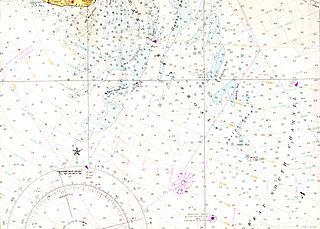
The station named Nantucket or Nantucket Shoals was served by a number of lightvessels that marked the hazardous Nantucket Shoals south of Nantucket Island. The vessels, given numbers as their "name," had the station name painted on their hulls when assigned to the station. Several ships have been assigned to the Nantucket Shoals lightship station and have been called Nantucket. It was common for a lightship to be reassigned and then have the new station name painted on the hull. The Nantucket station was a significant US lightship station for transatlantic voyages. Established in 1854, the station marked the limits of the dangerous Nantucket Shoals. She was the last lightship seen by vessels departing the United States, as well as the first beacon seen on approach. The position was 40 miles (64 km) southeast of Nantucket Island, the farthest lightship in North America, and experienced clockwise rotary tidal currents.
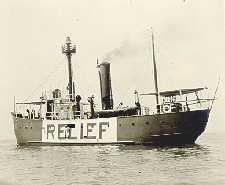
The United States lightship Huron (LV-103) is a lightvessel that was launched in 1920. She is now a museum ship moored in Pine Grove Park, Port Huron, St. Clair County, Michigan.

Wawona was an American three-masted, fore-and-aft schooner that sailed from 1897 to 1947 as a lumber carrier and fishing vessel based in Puget Sound. She was one of the last survivors of the sailing schooners in the West Coast lumber trade to San Francisco from Washington, Oregon, and Northern California.
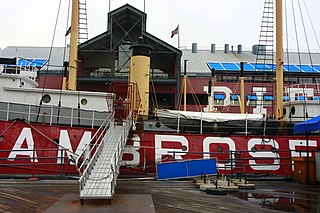
Lightship Ambrose was the name given to multiple lightships that served as the sentinel beacon marking Ambrose Channel, New York Harbor's main shipping channel.

The steamship Virginia V is one of two last operational examples of Puget Sound Mosquito Fleet steamers. She was once part of a large fleet of small passenger and freight carrying ships that linked the islands and ports of Puget Sound in Washington state in the late 19th and early 20th centuries. She is a Seattle landmark and a National Historic Landmark.

Cape Mendocino Light was a navigation light at Cape Mendocino, California. The former lighthouse was relocated to Shelter Cove near Point Delgada, California in 1998, and the historic Fresnel lens to Ferndale, California, in 1948. An automated beacon operated for a number of years but was removed in May 2013.

United States Lightship 101, now known as Portsmouth as a museum ship, was first stationed at Cape Charles, Virginia. Today she is at the Portsmouth Naval Shipyard Museum in Portsmouth, Virginia. Portsmouth never had a lightship station; however, when the vessel was dry docked there as a museum, she took on the pseudonym Portsmouth. A National Historic Landmark, she is one of a small number of surviving lightships.

The United States Coast Guard Cutter Fir was the last lighthouse tender built specifically for the United States Lighthouse Service to resupply lighthouses and lightships, and to service buoys. Fir was built by the Moore Drydock Company in Oakland, California in 1939. On 22 March 1939, the U.S. Lighthouse Tender Fir was launched. She was steam driven with twin screws, 175 feet (53 m) in length, had a beam of 32 feet (9.8 m), drew 11 feet 3 inches (3.43 m) of water, and displaced 885 tons. Fir was fitted with a reinforced bow and stern, and an ice-belt at her water-line for icebreaking. She was built with classic lines and her spaces were lavishly appointed with mahogany, teak, and brass. The crew did intricate ropework throughout the ship. The cost to build Fir was approximately US$390,000. Fir's homeport was Seattle, Washington for all but one of her fifty one years of service when she was temporarily assigned to Long Beach, California when USCGC Walnut was decommissioned on 1 July 1982.

United States lightship Nantucket (LV-112) is a National Historic Landmark lightship that served at the Lightship Nantucket position. She was the last serving lightship and at time of its application as a landmark, one of only two capable of moving under their own power. She served as the lightship for such notable vessels as the liners United States, Queen Mary, and Normandie.
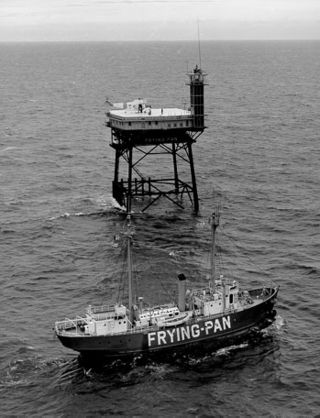
Frying Pan (LV-115) is a lightvessel moored at Pier 66a in the Chelsea neighborhood of Manhattan in New York City. It served at Frying Pan Shoals, off Cape Fear in North Carolina, for over 30 years.

United States lightship Relief (WLV-605) is a lightvessel now serving as a museum ship in Oakland, California. Built in 1950, she is one of a small number of surviving lightships, and one of an even smaller number built specifically for the United States Coast Guard. Along with her sister ship, the WLV-604 Columbia, she is a good example of the last generation of lightships built. She was declared a National Historic Landmark in 1989.

Baltimore is a preserved steam-powered tugboat, built in 1906 by the Skinner Shipbuilding Company of Baltimore, Maryland. She is formerly the oldest operating steam tugboat in the United States, but at present does not hold an operating license issued by the US Coast Guard, so is unable to leave her dock at the Baltimore Museum of Industry on Key Highway, Baltimore. Her hull is not capable of operating on open water. Baltimore was built and operated as a harbor inspection tug, capable of acting as a municipal tugboat for city barges, as well as an official welcoming vessel and VIP launch, an auxiliary fireboat, and as a light icebreaker.

Lightship No. 114, later U.S. Coast Guard WAL 536, that served as lightship Fire Island (NY), Examination Vessel, Diamond Shoal (NC), 1st District relief vessel, Pollock Rip (MA) and Portland (ME). After decommissioning in 1971, in 1975 the lightship became a historic ship at the State Pier in New Bedford, Massachusetts. She received little maintenance, and eventually sank at her moorings in 2006 and was sold for scrap the next year.
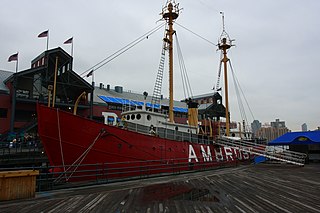
The United States Lightship LV-87/WAL-512 (Ambrose) is a riveted steel lightship built in 1907 and served at the Ambrose Channel lightship station from December 1, 1908, until 1932, and in other posts until her decommissioning in 1966. It is one of a small number of preserved American lightships, and now serves as a museum ship at the South Street Seaport Museum in southern Manhattan, New York City.

Diamond Shoal Lightship No. 71 (LV-71) was a lightship of the United States Lighthouse Service. She is most remembered for her sinking in 1918 during World War I when a German U-boat attacked her off North Carolina. Her shipwrecked remains were listed on the National Register of Historic Places in 2015.

The Grays Reef Light is a lighthouse located in northeastern Lake Michigan, 3.8 miles (6.1 km) west of Waugoshance Island in Bliss Township, Michigan. It was listed on the National Register of Historic Places in 2005.
United States lightship No. 113, known as Swiftsure, was a steel-hulled lightship in commission with the United States Lighthouse Service as LV-113 from 1929 to 1939, and in the fleet of the United States Coast Guard as WAL-535 from 1939 until 1968. During World War II, she was given the designation USS YP-397.




















